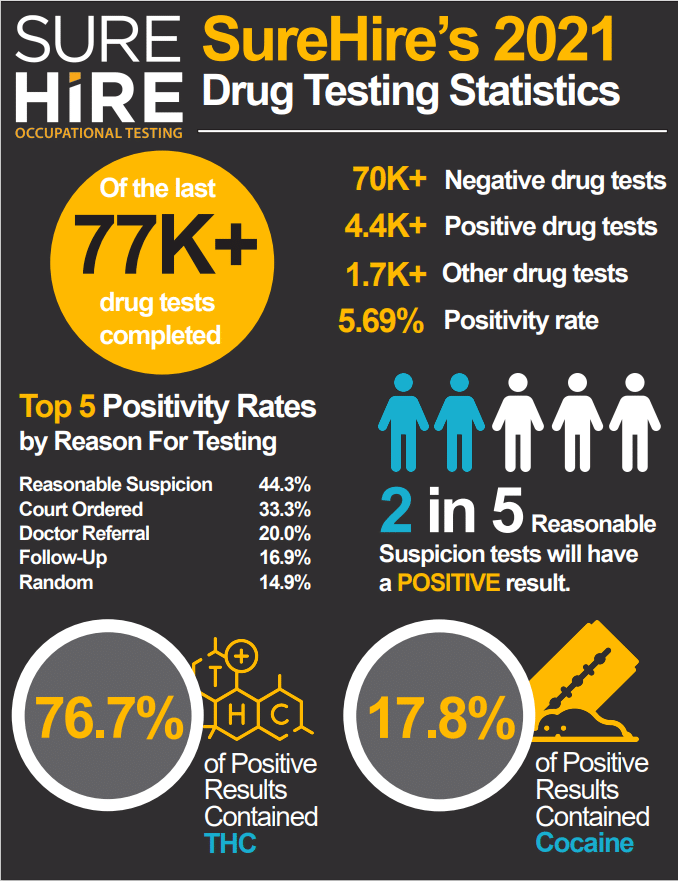TAKEAWAY: Developing an effective drug and alcohol policy requires a knowledge of the testing types and knowing which one is most applicable to your business needs. Here’s what you need to know about the 5-panel urine test and the 5-panel oral fluid drug test.
Jump Ahead
Canadian rights to legally consume cannabis products do not extend to using it in the workplace or showing up to work impaired. This is even more true for workers in safety-sensitive positions. Still, a Conference Board of Canada study reported that almost 25% of recreation cannabis users and more than 25% of those who use medical marijuana work in safety-sensitive positions. And an ADP study further revealed that 63% of workers consume cannabis before work, while 47% consume it during work.
This puts employers in a difficult position. They must protect the health and safety of workers and the public, but they also have to accommodate. As part of a comprehensive drug testing policy, drug testing and online education and training can help.

SureHire’s drug positivity rates reveal a staggering truth about safety-sensitive positions and Cannabis use. Of the last 77 thousand tests completed, our positivity rate was 5.69%. Over 75% of those positive tests contained THC and the most common reason for testing was for Reasonable Suspicion. Furthermore, 40% of tests completed due to reasonable suspicion/reasonable cause produced a positive result.
Effective Risk Mitigation begins with educating your workforce on Reasonable Suspicion. SureHire offers both self-study and in-person Reasonable Suspicion Training (RST) options to help employers educate their workforce.
Contact us today to book a private, in-person RST Session or register for self-study RST online.
Drug tests are commonly referred to by the number of panels or drugs, they test for. The 5-Panel drug test screens for recent use of 5 of the most encountered drugs in the workplace, including cannabis. It allows employers to implement a cost-effective and targeted drug testing program to help prevent industrial accidents, improve productivity and reduce absenteeism associated with drug use.
Drugs Tested in the 5-Panel Test
Most 5-Panel drug tests include 5 commonly abused substances: marijuana, cocaine, opiates, amphetamines, and Phencyclidine (PCP). Commercial names for opiates include Codeine, Morphine, and Heroin (6 AM). Methamphetamine and MDMA are common amphetamines, and street names include Meth, Molly, Extract, and M. PCP is often referred to as angel dust or rocket fuel.
When to Use the 5-Panel Drug Test
The U.S. Department of Transportation (DOT) regulations requires a 5-Panel Drug Test while the Canadian Model recommends an 8-Panel Test. The 5-Panel test can be used in various situations. However, pre-employment testing is generally not permissible in Canada in a unionized workplace and only in limited circumstances in a non-unionized workplace. It is also important to note that if a lab confirmation is required in the case of 5-panel, oral-fluid express testing, an oral fluid 8-panel drug screen will be provisioned.
Other types of tests may be allowable under specific circumstances:
- Random drug testing as part of a broad policy to address drug and alcohol abuse in a dangerous workplace with a provable drug and alcohol problem
- Post-incident or post-accident testing if there is reason to believe drugs are a contributing factor
- Return-to-work testing if workers have received treatment for substance abuse and testing was made a condition for returning to work
- Reasonable cause testing if the employer believes the worker exhibits behaviours suggesting they are not fit for duty.
How 5-Panel Drug Tests are Conducted
5-Panel Drug tests can be conducted via urinalysis, hair follicles, or saliva (oral fluid). The most common, and the one recommended by the Canadian Model, is urinalysis. These can be either a lab-based test or point of care (POCT), also known as express testing. Lab-based testing involves the collection of samples, which are then sent to a laboratory for testing.
Lab-based testing is considered more accurate, but POCT tests can deliver results quickly, often within minutes, which is essential in some workplace situations. It may, however, take 2-5 business days to send samples to a lab and receive results back. POCT tests also tend to be more convenient for workers and less expensive to administer for employers.
A laboratory test must verify a positive POCT result to eliminate the possibility of a false positive and help ensure legal defensibility for any actions taken by the employer. Employing a Medical Review Officer (MRO) can also protect the company.

Please Note that Oral Fluid Express Panel 5 cannot be completed on its own, and must be completed in conjunction with the Oral Fluid Lab Panel 8. This is due to increased cut-off levels for POCT testing for THC, increasing the chance for THC use to go undetected. It’s also important to note that the Canadian Model for Providing a Safe Workplace does not approve of stand-alone POCT Oral Fluid testing under any circumstances.
Cut-off levels for 5-Panel Drug Tests
Cut-off levels are the level at which the concentration of a drug within a person’s system as indicated by the POCT or lab-based test indicates a safety risk. Employers can set their own acceptable cut-off levels as long as these are indicated in their drug and alcohol testing policy.
Most employers base their cut-off levels on either the Canadian Model or the DOT concentration limits and setting cut-offs ensures that all workers are treated equally when it comes to drug testing. There are different cut-off levels for urine and oral fluid testing. Here are the screening and confirmation levels for SureHire’s 5-panel drug screens.
Urine Drug Cut-Off Levels
Oral Fluid Cut-Off Levels
What are Windows of Detection?
Windows of detection are the time in which a drug can still be detected by a test. They are affected by the type of test, the drug, and the amount of usage. For example, in casual marijuana use (once per week), the THC metabolite is detectable for approximately three to four days. However, with chronic use (every day), tests can detect THC for several weeks.
The liver metabolizes drugs into more water-soluble forms that can be excreted in urine by the kidneys. Many drugs, including opioids, are entirely excreted in the urine within two to three days. Others, such as PCP, stay in the bloodstream longer and are converted to metabolites that are then slowly excreted. They can be detected for up to a week in urine.
Oral fluid testing offers a much shorter window of detection, usually 12 to 24 hours, but it is an excellent method for detecting current impairment.
How Are Results Interpreted?
DOT requires companies to send positive test results to a Medical Review Officer (MRO) who interprets the results, reports on them, and recommend a course of action. The Canadian Model recommends employers use an MRO to receive and interpret drug testing reports in confidence. The MRO also discusses the test results with the worker and seeks reasons for positive, adulterated, substituted, or invalid results. This is important for situations such as the use of medical marijuana.
Finally, the MRO makes a determination that is reported to the employer.
SureLink – Your Secure, Online Results & Bookings Portal
We recognize that our clients need technology and systems that make their experience seamless, so they can maintain strong, healthy, and long-lasting workforces without interruption.
SureLink is an innovative solution that not only allows you to view test results but also access dashboard report snapshots, create live appointment bookings, track participant data, view appointment confirmation history, enroll your workers in online courses, and monitor course progress, receive important alerts and notifications, and more!
Our user interface makes navigation simple and customizable features allow for adjustments based on your company’s needs.

Looking for a Provider?
SureHire offers a comprehensive suite of testing options for employers in Canada and in the US. We also offer impairment awareness training and substance abuse supports to complete your drug and alcohol testing program.
You May Also Be Interested In…
- SureHire Occupational Testing Acquires COHR Health: A Positive Step Towards Safe, Healthy, Productive Workforces and CommunitiesWe are thrilled to announce that today, May 6, 2024, SureHire Occupational Testing has officially acquired COHR Health, a well-known leader in occupational health services. Read on…
- Occupational Testing Use Case – Mining
 In this case study, we will explore how mining companies can use various types of occupational tests to reduce Total Recordable Incident Rates (TRIR) long term.
In this case study, we will explore how mining companies can use various types of occupational tests to reduce Total Recordable Incident Rates (TRIR) long term. - 9 Strategies to Keep Workers Cool on Drilling Sites During Hot Summer Months
 This article delves into strategies to keep workers cool and safe on drilling sites during the hot summer months.
This article delves into strategies to keep workers cool and safe on drilling sites during the hot summer months. - Hearing Conservation Basics: How to Manage Occupational Noise
 Learn how to proactively mitigate occupational noise risks and help prevent NIHL among workers.
Learn how to proactively mitigate occupational noise risks and help prevent NIHL among workers. - Occupational Testing Use Case – Manufacturing
 Explore how manufacturing companies can use various types of occupational testing to assess job applicants, including statistics that show how that can reduce your Total Recordable Incident Rate over the long term.
Explore how manufacturing companies can use various types of occupational testing to assess job applicants, including statistics that show how that can reduce your Total Recordable Incident Rate over the long term. - How to Improve Workplace Safety Communication: Seven Strategies for Success
 This article explores seven practical strategies to improve workplace safety communication. From regular training sessions to utilizing various communication channels, these approaches will enhance the effectiveness of safety messages and ensure they reach and resonate with every employee.
This article explores seven practical strategies to improve workplace safety communication. From regular training sessions to utilizing various communication channels, these approaches will enhance the effectiveness of safety messages and ensure they reach and resonate with every employee.

